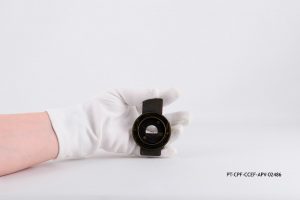Documento Mês – Equipamento Fotográfico

Obturador de guilhotina
Coleção António Pedro Vicente, Coleção de Câmaras e Equipamento Fotográfico, PT/CPF/CCEF/APV/02486
© Centro Português de Fotografia/DGLAB/MC
Foi em França que mais se fez sentir o movimento revolucionário que se estendeu, na verdade, a todo o ocidente. Foi um ponto de viragem para a economia e para a sociedade na contemporaneidade, redesenhando-se todo o cenário político de então. A Revolução Francesa teve início em 14 de julho de 1789, com a Tomada da Bastilha e, num segundo momento, tem lugar uma revolta violenta que aterroriza todos os estratos sociais. Sem quaisquer salvo condutos, o Rei Luís XVI, condenado à morte por alta traição e crimes contra o Estado, foi enviado para a guilhotina em 21 de janeiro de 1793, e esta tornou-se então um símbolo do Reino de Terror, tendo sido usada até 1977.
Recordando esse sangrento episódio da história, apresentamos um dispositivo fotográfico cujo nome e funcionamento se inspiraram nesse mortífero aparelho, o obturador de guilhotina.
In France, the revolutionary movement that eventually spread throughout the West was most strongly felt. It was a turning point for the economy and society at the time, reshaping the entire political landscape. The French Revolution began on 14 July, 1789, with the Storming of the Bastille. Later on, a violent revolt took place that terrorised all social strata. Without any safe conducts, King Louis XVI, condemned to death for high treason and crimes against the state, was sent to the guillotine on 21 January, 1793, and the guillotine became a symbol of the Reign of Terror, remaining in use until 1977.
Recalling this Bloody episode in history, we present a photographic device whose name and operation were inspired by this deadly apparatus — the guillotine shutter.
Guillotine shutter
António Pedro Vicente Collection, Cameras and Photographic Equipment Collection, PT/CPF/CCEF/APV/02486
© Centro Português de Fotografia/DGLAB/MC